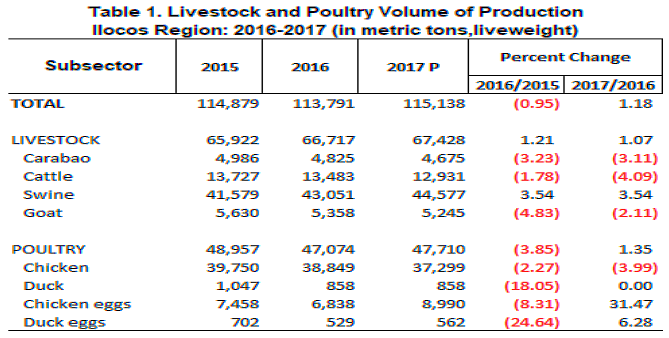Total Livestock and Poultry Volume of Production in Ilocos Region grew by 1.18 percent in 2nd semester 2017. Production in the livestock subsector increased by 1.07 percent. It accounted for 58.56 percent of the total output. Hog was the main contributor to the subsector’s output increment. The poultry subsector with 41.44 percent contribution to the total output grew by 1.35 percent. Chicken eggs and duck eggs were the catalyst of said growth with output gains of 31.47 percent and 6.28 percent, respectively.

Source: Quarterly/Semestral Backyard Livestock and Poultry Survey (BLPS) and Commercial Livestock and Poultry Survey (CLPS), PSA – Preliminary Results
In terms of distribution by animal and product type, swine contributed the biggest share to the total production of about 38.72 percent, followed by chicken with 32.40 percent, cattle with 11.23 percent, chicken eggs with 7.81 percent, goat with 4.56 percent, carabao with 4.06 percent, and meager shares of 0.75 percent and 0.49 for duck and duck eggs, respectively.


CARABAO
Carabao production in Ilocos Region registered an output drop of 3.11 percent. Total carabao inventory as of July 1, 2017 was estimated at 166,608 heads. It was higher by 1.17 percent than last year’s total headcount of 164,674 heads. Backyard farms were building up stocks especially breeders. Backyard farms accounted 99.75 percent of the total carabao population while the remaining 0.25 percent were commercial farms.

CATTLE
Cattle production was estimated at 12,931 metric tons. It posted a drop of 4.09 percent during the period. The total count of cattle as of July 1, 2017 was 297,050 heads, lower by 0.80 percent as compared to the same period last year. About 99.16 percent of the total inventory were in the backyard, while the remaining 0.84 percent were in the commercial farms.

SWINE
Total swine or hog production reached 44,577 metric tons liveweight. It was 3.54 percent higher than last year’s level of 43,051 metric tons liveweight (Table 1). Total inventory of swine as of July 1, 2017 was 557,358 heads, higher by 1.40 percent than last year. Out of this total inventory, 81.70 percent were in backyard farms, while 18.30 percent were in commercial farms. The number of swine on both backyard and commercial farms grew by 0.15 percent and 6.56 percent, respectively.

GOAT
Production of goat for the 2nd semester 2017 was 5,245 metric tons. It posted a drop of 2.11 percent compared to the 2016 output of 5,358 metric tons liveweight. As of July 1, 2017, the total inventory of goat was 445,657 heads. It increased by 4.48 percent from the previous year’s inventory of 426,542 heads. Building up of stocks specially breeders in backyard farms was noted during the period. Around 98.56 percent were raised in backyard farms while the remaining 1.44 percent were raised in commercial farms.

CHICKEN
Volume of chicken production at 37,299 metric tons decreased by 3.99 percent in 2nd semester 2017. This is despite the increment of 10.61 percent of total chicken inventory as of July 1, 2017 compared to last year’s headcount of 8,507,723 heads. Late replenishment of stocks and temporary closure of some commercial broiler farms were noted during 2nd semester 2017. These can be attributed to the tight or limited supply of Day-Old-Chicks from Central Luzon that was affected by Bird Flu during the period.

On the otherhand, chicken egg production increased by 31.47 percent growth relative to 2016 (Table 1). This can be attributed to expansion of some layer farms in Ilocos Norte, additional farm in Ilocos Sur, and more backyard raisers of adult females (native chicken).
DUCK
The total volume of duck production in July–December 2017 was 858 metric tons, same as the output last year of same period. For duck egg, volume of production grew by 6.28 percent or from 529 metric tons last year to 562 metric tons this year (Table 1). The total duck inventory in the region as of July 1, 2017 was 400,411 birds. It slightly increased by 0.95 percent from last year's inventory of 396,640 birds. About 93.01 percent of the total duck population were raised in backyard farms while 6.99 percent were grown in commercial farms.

TECHNICAL NOTES
- Production. Refers to the volume of indigenous (locally-raised) animals disposed for slaughter which include animals exported or shipped-out for slaughter (in “metric tons” and in “liveweight equivalent”).
- Livestock – farm animals kept or raised for consumption, work or leisure. In general, poultry is separated as a distinct group of farm animals. For purposes of census and surveys, livestock covers only those that are tended and raised by an operator.
- Poultry - a collective term for all domesticated avian for the purpose of food consumption or, the carcass of such avian dressed/processed for human consumption.
- Animal Inventory (also, Animal Population) – the number of domesticated animals in head present in the farm at specific reference date.
- Backyard Farm/Raiser- refers to any farm or household raising at least one head of animal or bird and does not qualify as a commercial farm.
- Commercial Livestock Farm/Operator - refers to any livestock operator or farm which operation satisfies at least one of the following conditions: a) at least 21 head of adults and zero young b) at least 41 head of young animals c) at least 10 head of adults and 22 head of young animals.
- Commercial Poultry Farm/Operator- refers to any poultry operator or farm which operation satisfies at least one of the following conditions: a) 500 layers or 1,000 broilers b) 100 layers and 100 broilers if raised in combination c) 100 head of duck regardless of age.
- Swine. A non-ruminant, cloven-footed animal belonging to family suidae with simple stomach, having a snout, large number of mammary glands, thin skin, and heavy bristles. It is also called hog or pig.
SGD. SOCRATES L. RAMORES
Regional Director



